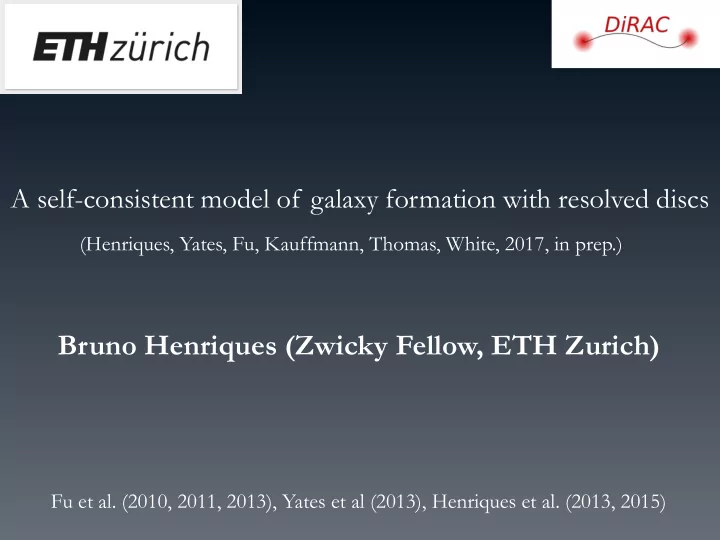

A self-consistent model of galaxy formation with resolved discs (Henriques, Yates, Fu, Kauffmann, Thomas, White, 2017, in prep.) Bruno Henriques (Zwicky Fellow, ETH Zurich) Fu et al. (2010, 2011, 2013), Yates et al (2013), Henriques et al. (2013, 2015)
Why we need SN feedback? The underlying distribution of dark matter is determinant. The most important problems in galaxy formation can be identified in a model just with accretion and cooling
Gas Reincorporation longer reincorporation time-scales for gas ejected by SN in low mass galaxies lower number density at early times, stronger build up at later times Henriques et al. 2013 in agreement with Oppenheimer & Dave 2008 hydro should correctly follow the gas flows
100% used SN energy used out of the disc out of the halo Mass-loading halo Henriques et al. 2015
Galaxy formation with resolved discs (Henriques, Yates, Fu, Kauffmann, Thomas, White, 2017, in prep.) Cooling H 2 Formation exponential profile with r d separation between H 2 , scaling with current halo spin HI and ionised r i stars cold gas detailed chemical enrichment model H 2 based star formation Radial inflow
Galaxy formation with resolved discs Cooling forms HI which settles into an exponential disk r d cold gas
HI formation and conversion into H 2 Cooling forms HI which settles into an exponential disk r d cold gas
HI formation and conversion into H 2 Theoretical studies show HI H 2 conversion depends mostly on gas surface density Krumholz et al. 2009: Blitz & Rosolowsky:
Star Formation Kennicutt 1998
Radial Inflow Cold gas is denser in the centre of disks star formation happens at the centre radial inflow of gas is required to avoid H 2 depletion in the centre NO INFLOW WITH INFLOW H2 H2
Detailed Chemical Enrichment M metals =yM * Detailed chemical enrichment model: the mass of each element produced in stars of different masses (i.e. ages) and initial metallicities is computed. SN-Ia Yates et al. (2013)
Galaxy formation with resolved discs (Henriques, Yates, Fu, Kauffmann, Thomas, White, 2017, in prep.) Cooling H 2 Formation exponential profile with r d separation between H 2 , scaling with current halo spin HI and ionised r i stars cold gas detailed chemical enrichment model H 2 based star formation Radial inflow
Masses and SFRs Over all shape of the stellar mass function is unaffected because changing the SFE just moves everything left or right. SFRs of low mass galaxies are higher, because there is no surface density threshold for star formation.
Cold Gas Properties you can have less gas and still form stars
Structural Properties A model in which the sizes are given by the angular momentum of the halo works. morphologies not terrible either
Stellar and Gas Phase Metallicities Gradients are not as steep as observed. Can be if we blow out all the metals in low mass galaxies, but then normalisation too low. Do we trust the normalization?
Gradients - Comparison with CALIFA
Gradients - Comparison with MaNGA
Summary We now have a self-consistent analytic model of galaxy formation with resolved properties: cooling; HI and H 2 ; H 2 based SF; radial inflow; chemical enrichment Global properties look as good as in Henriques et al. 2015: SMFs, SFRs, sizes, morphologies, better gas properties . In low-mass galaxies there is a tension between global gas metallicity and flat gradients: need to blow out metals in the centre too low global metallicity
Recommend
More recommend